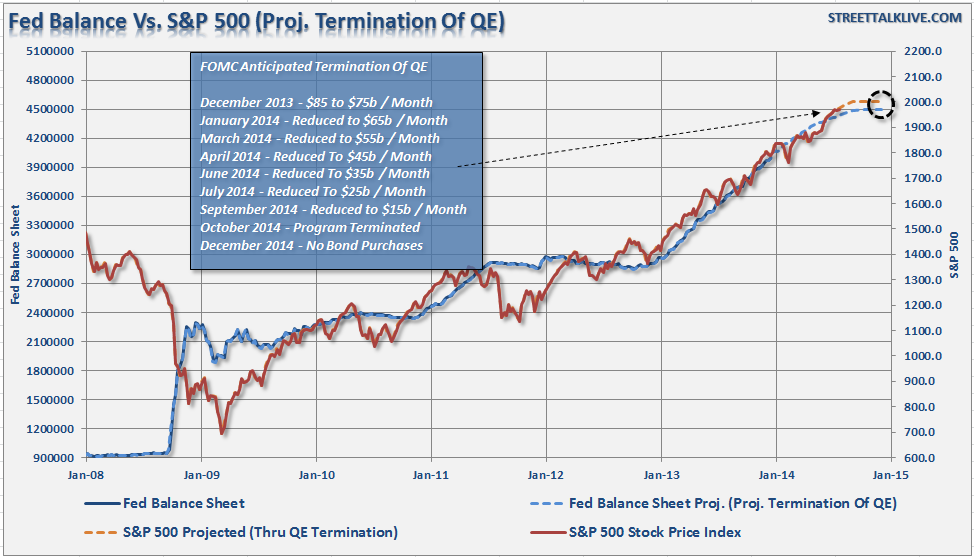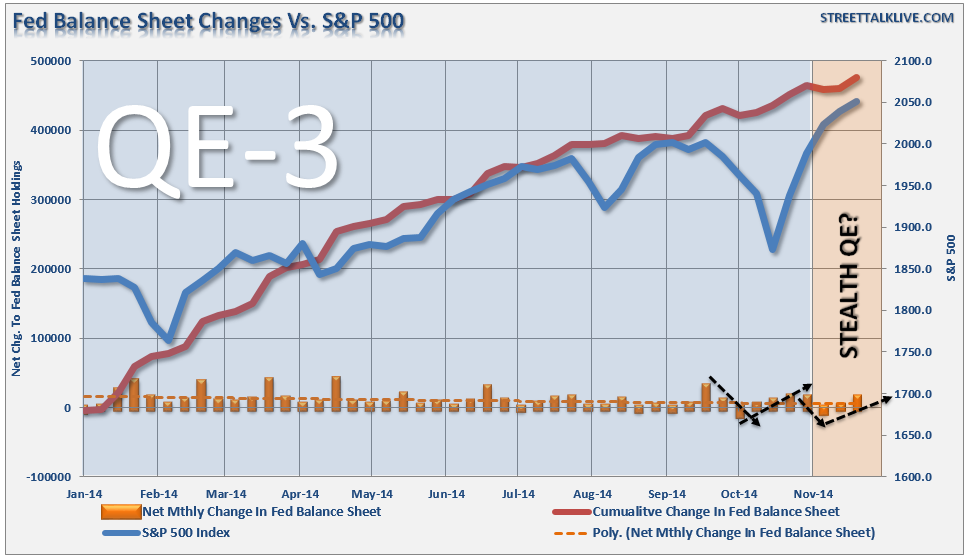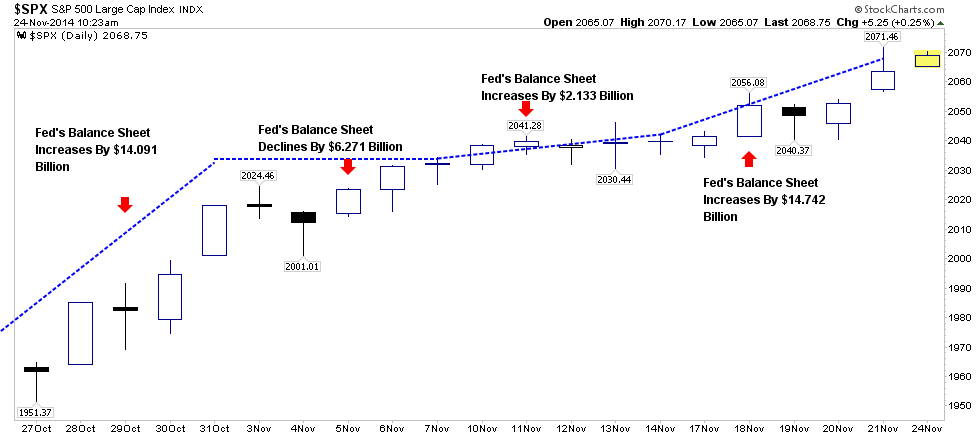A couple of weeks ago in the weekly newsletter I discussed the series of events behind the decline of the market in October and the subsequent surge.
"The chart below shows the series of events that has propelled the markets higher in recent days as a massive short covering rally, on declining volume, has taken place.
The chart below is an hourly chart of the market over the last month. It shows the flip-flop of Fed President Bullard, the end of QE, the impact of 12 day old news that Japan’s GPIF was upping their allocation to equities, which was followed by a surprise announcement that Japan would double down on their failing QE program. That is how you concoct an equity rally that forces short positions to liquidate 'en masse'.
As noted in the chart above, the Federal Reserve announced the completion of their "bond buying/balance sheet expansion" program following the two-day FOMC meeting at the end of October.
QE Is Dead, Long Live QE
As discussed previously, the correlation between the Fed's balance sheet expansion program and the subsequent changes in the S&P 500.
"The reason for the rise, of course, has been almost solely due to the Federal Reserve’s ongoing, but currently declining, liquidity injections into the financial markets.
As you can see, there is a very high correlation between the Fed’s balance sheet increases and the financial markets. With the Fed now “tapering” those purchases and ending them theoretically by October, this support will fade."
When the Federal Reserve balance sheet has flattened out due to temporary periods where QE programs were not active, the market has stagnated or had fairly sharp corrections as in the summer of 2010 and 2011. It was following these declines that the Federal Reserve quickly acted to reinstate those liquidity programs to support asset price inflation and stabilize economic disruption.
So, with the Federal Reserve now "out" of the bond buying game domestically what is continuing to support the recent rise in the S&P 500?
The current assumption is that it is the interventions from the Bank of Japan and the ECB that is lifting asset prices higher. However, both of those programs are far too small to create the liquidity needed to boost domestic markets substantially higher. Furthermore, they do not provide direct liquidity to domestic financial institutions for a continuation of the "carry trade" to the degree that the Federal Reserve programs do.
The answer lies in the Federal Reserve balance sheet itself. Despite the Fed's statement that they ended their liquidity support in October, the reality is that it is still ocurring behind the scenes in "stealth mode." The chart below shows the S&P 500 index overlaid against the current size of the Fed's balance sheet. The bars at the bottom of the chart are the net monthly changes to the Fed's balance sheet.
The recent market plunge at the beginning of October coincides with a relatively sharp reduction in bond purchases by the Fed. However, even as Fed President Bullard's comments are credited with the surge off the October lows, those comments also coincided with an expansion of the Fed's balance sheet.
While there was a brief reduction in buying in the first week of November, which coincided with the markets "consolidation process," as shown below, the surge higher over the last two weeks corresponds with additional expansion of the Fed's balance sheet. That increase in liquidity has flowed into the financial markets pushing asset prices higher.
The ongoing increase in the Fed's balance sheet, combined with a vicious short-covering rally, has now pushed markets to new highs.
It is likely that the Federal Reserve is continuing their support in light of the global weakness that currently prevails in the Eurozone, Japan, Russia and China. The growth miracle in emerging markets is over, not surprisingly since their economies depend upon the generosity of their neighbors, and the Eurozone itself is just a statistical anomaly away from a recession.
The Fed is aware of the deflationary impact that the global slowdown will have on the U.S. Furthermore, the currently extremely cold weather could easily disrupt an already fragile "growth story" just as was witnessed in the first quarter of this year.
Despite valuations, bullish sentiment and complacency rapidly hitting extremes after the brief October correction; investors have been taught that the "Fed will not let the markets decline." This belief continues to push investors to change markets with disregard of the rising underlying risk. Such behavior is extremely dangerous in the long term and has always ended in tears.
However, in the short-term, bullish optimism reigns as risk-taking is the "gift of choice" this winter season. Investors are making their list, and checking it twice, as they prepare for the expected arrival of the year-end "Yellen Claus" rally. The only question is whether "Jack Frost" once again steals the show dashing hopes for economic recovery and negatively impacting profit margins.
For investors, the only option seems to be long which has always been the case in late stage bull market cycles. However, even if economic conditions do continue to improve, equity prices will fall sharply at some point, inflicting painful losses on investors as fear gives way to greed. At that point, even the Fed's interventions may fail to halt the ensuing decline.




